Mistakes You Make When Writing Content for the Web
There is only a 16% chance someone will actually read your entire blog article.
Staggering, isn’t it? Research on how modern consumers engage with information online has found that while 79% of page visitors will skim the information, only 16% will consume every word. Formatting your articles appropriately is key to success at business blogging.
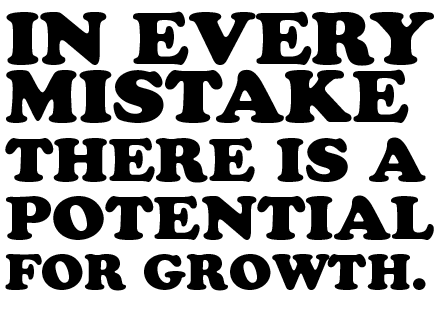
Still, you need to avoid mistakes under review in this article at any cost. Remember that poor text formatting pushes off your visitors…
The same study found that a well-formatted version outperformed the same article without factors like subheadings and numbered lists by 58%! Who doesn’t want to improve the performance of their content nearly 60% by implementing a few simple tactics to increase readability? Let’s jump right into the various formatting mistakes that can overshadow all of your other efforts at content writing:
To learn more about the basics of preparing your posts to publish, we recommend How to Format the Perfect Blog Post: 10 Killer Tips.
1. The “Wall of Text”
It doesn’t matter how much you enjoy the subject matter, nothing makes a blog reader’s eyes cross faster than a “wall of text,” that lacks any formatting whatsoever. The concept is illustrated below:
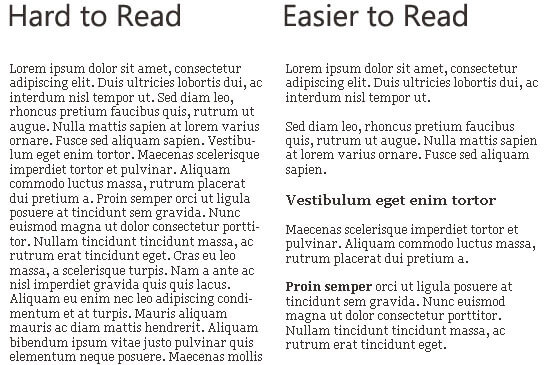
As thought leader Jeff Bullas points out, the problem with failing to format completely is that you’ll overwhelm your readers. “We are a time-poor society that is bombarded with messages, ideas, and information. The challenge is often not what to read, but what not to read.”
When content writing, remember that your readers are very busy people. Respect their time and attention by breaking your content into easily-digestible chunks, punctuated by descriptive subheaders.
2. Poor Use of White Space
Graphic designers have long known that including white space, or negative space, around an object will draw the viewer’s attention toward it:
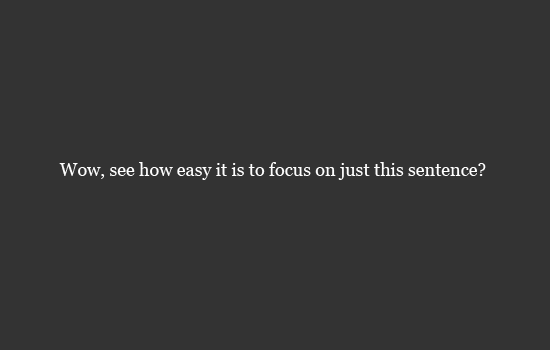
The same concept is true for written content, and far too few content marketers take full advantage of this fact. Why not separate your thesis statement, an important question, or other key components of your text into their own, tiny paragraphs?
It’s certainly worth trying, isn’t it?
Some studies have found that white space increases comprehension by 20% or more. Use this truth to your advantage!
3. Overuse of Bolding
In the early days of SEO, bold text was something of an optimization tactic. Search engines figured that if something was important enough for you to emphasize, that it should clearly be used to categorize your content. This tactic was quickly abused, leading to loads of hard-to-read articles online:
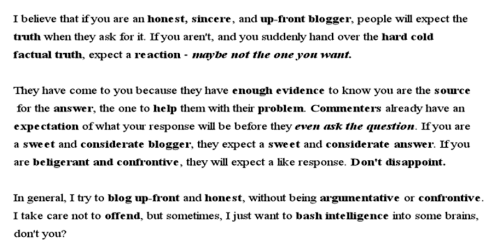
Search engines no longer place any additional weight on bold text, but from a reader-experience perspective, approach this tactic with extreme caution.
Occasionally bolding text can allow you to emphasize important points, increasing the readability of your content. Peppering your content with bolded text, or even bolding entire sections longer than a sentence or two will make your content writing very difficult to read, or make your new readers think you’re shouting at them.
4. Tiny Text
A tiny font on your blog has never been a best practice. If your words are smaller than an 8 point, there’s a good chance your readers will hit the “back button” before zooming in. However, in an age where mobile devices are quickly overtaking personal computers as the preferred way to browse the internet, your tiny text probably looks even worse on a tablet or mobile device.
Invest in a Responsive template that supports text in a readable font. If you’re unable to customize your font size or you’re stuck with 6-point words, your content writing efforts almost certainly won’t pay off.
5. Avoid Too Much Italics or Script
Sometimes, a few words of italics are just the thing. It allows you to provide emphasis, or infuse your writing with a conversational tone. Italics can draw distinction between examples and supporting text, or allow you to distinguish dialogue and quotations.
However, writing entire blog entries, multiple sentences, or paragraphs in italics or script? It’s probably wise to avoid this at all costs. Doesn’t the example below make your head swim?
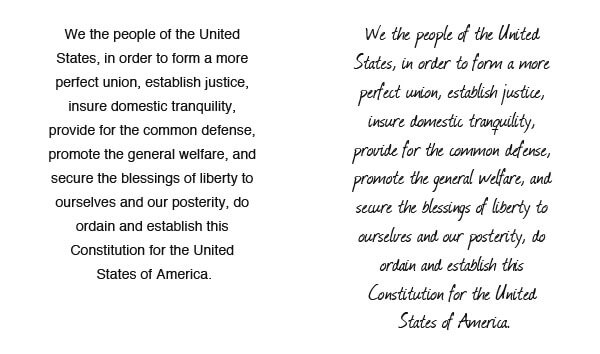
6. Hard-to-Read Colors
In the early days of blogging, many of us were thrilled to learn we could customize colors on our blog, and abused this tactic. Today, it’s a lot less common to see business blogs using white text against a dark font, but it still happens. And it isn’t pretty, to say the least:
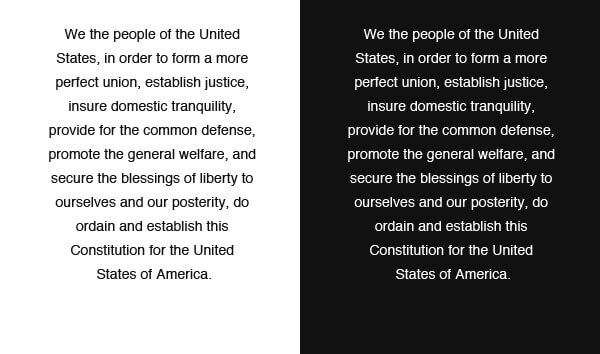
If you’re using a blog layout with pre-set colors decreasing your readability, stop all content writing efforts and buy a new layout – stat. Your current audience will be grateful.
7. Using Caps Lock
DOESN’T IT MAKE YOU KIND OF UNCOMFORTABLE WHEN PEOPLE TYPE IN ALL-CAPS?
In most cases, people are going to feel like you’re shouting at them. With rare exceptions, all-caps have no place in content writing for business. You’ll get your point across far more effectively without yelling. Just like your Mother always told you, you’ll attract more flies with honey than vinegar; and even bolding text is probably going to get your further than your caps lock key.
8. Deceptive Subheadings
Using subheaders throughout your blog to break up your text and improve the scan-ability of your content is among the most important formatting actions you can take. It really only takes a few minute, and it will increase your readability drastically! However, don’t overpromise and under deliver when it comes to subheaders and content writing. Don’t promise to change your writer’s lives if you’re just explaining a simple hack. The readers who do delve into the content of the section will perceive it as dishonest.
9. Undescriptive Subheadings
Without question, one of the most common content writing mistakes I see newer bloggers make is failing to write good subheaders. I suppose poorly-written subheadings are better than none, but not by much. The following are close variations of actual subheadings I’ve encountered on both web articles and pages in the not-so-distant past:
- What to Do Now
- What You Need to Know
- Your Next Steps
Do you think readers can extrapolate any valuable information about what they’ll learn in that section from those headings? Not so much. It’s also critical to keep in mind that search engines place emphasis on subheadings as a tool for categorizing and ranking your content. You’ll struggle to rank for important keywords on your topic if you’re using generic descriptions that lack relevant keywords or information. Instead of the generic headers above, write subheadings that resemble the following:
- What to Do Now to Improve Your Content Marketing
- What You Need to Know About Blogging for Business
- Your Next Steps to a SEO-Rich Blog Article
To learn more about the latest SEO best practices, check out How to Optimize Your Blog Posts for SEO: an Easy-Peasy Guide.
10. Using Multiple Ideas per Paragraph
In a study of how consumers read content on the web, Jakob Nielson found that the first couple words of your paragraphs are crucial. If your readers aren’t immediately drawn in, they’re probably on to your next subsection. Keep this in mind while content writing, and avoid trying to fit multiple concepts into a single paragraph.
If this means you’re delivering paragraphs that are short, it’s okay. You’re not being graded against traditional MLA style. If you’ve covered an idea sufficiently, end your paragraph and move onto the next.
11. Failing to Use Links and Quality Graphics
If you’re using terrible stock photos or not citing any sources, you’re coming across like a charlatan. Nielson’s study also found that credibility is of the utmost importance to web readers, and they use a few factors to determine whether your content writing is trustworthy within a few seconds:
- High-quality graphics
- Natural, correct writing
- Use of Links
Your content has to pass the “blink test” of web users who are frankly sick and tired of low-quality content. Show that you know your stuff by investing in custom or quality images, and citing sources throughout your content.
12. Burying Your Conclusion at the End
If you typically write a conclusion for your content in the last paragraph, that shows you were paying attention in English class. However, while this tactic may be technically correct, it’s simply not optimized for the way we consume information today.
The idea of giving away your conclusion in the first paragraph is known as the “inverted pyramid;” you present your thesis statement immediately, and then back it up with information. Also, it’s actually a lot less newfound than you think. Journalists have been using this approach to “hook” readers’ attention for decades.
13. Not Numbering Your Lists
Numbered lists are almost always a win for content writing. They’re a fabulous way to provide an immense amount of value and research to your reader, which is why they’re one of the most popular forms of content online. However, if you fail to number your lists, your content’s going to be a lot less engaging than you’d hoped. It will also be more difficult for readers to reference, and navigate. By all means, number your posts – it only takes about 15 seconds, and its well worth your time.
14. Failing to Call Your Readers to Action
Another all-too-common mistake when it comes to content writing is failing to invite your readers to take action at the end of your post. Do you want them to subscribe? Convert into a lead? Leave a comment? By all means, invite them to engage by providing a link or a thought-provoking question. Failing to end your article with an invitation can ruin your chances of converting one-time readers into dedicated community members.
What are the most common blog formatting mistakes you see? Are there any tips or hacks you’d add to this list? Share your thoughts in the comments!

Comment (1)
This is an insightful post that highlights the value of learning through mistakes in content creation. Your advice on embracing errors as part of the process is encouraging for writers aiming to improve their skills. Thank you for sharing practical tips that make the journey less daunting and more productive.